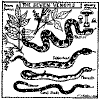by Ernest Thompson Seton
Snakes are to the animal world what toadstools are to the vegetable world--wonderful things, beautiful things, but fearsome things, because some of them are deadly poison.
Taking Mr. Raymond L. Ditmars (This article is chiefly a condensation of his pamphlet on "Poisonous Snakes of the United States," and is made with his permission and approval), as our authority, we learn that out of one hundred and eleven species of snakes found in the United States, seventeen are poisonous. They are found in every state, but are most abundant in the Southwest.
These may be divided into Coral Snakes, Moccasins, and Rattlers.
The Coral Snakes are found in the Southern States. They are very much like harmless snakes in shape, but are easily distinguished by their remarkable colors, "broad alternating rings of red and black, the latter bordered with very narrow rings of yellow."
The Rattlesnakes are readily told at once by the rattle.
But the Moccasins are not so easy. There are two kinds ; the Water Moccasin, or Cotton-mouth, found in South Carolina, Georgia, Florida, --Alabama, and Louisiana, and the Copperhead, which is the Highland, or Northern Moccasin or Pilot Snake, found from Massachusetts to Florida and west to Illinois and Texas.
Here are distinguishing marks: The Moccasins, as well as the Rattlers, have on each side of the head, between the eye and nostril, a deep pit.
The pupil of the eye is an upright line, as in a cat; the harmless snakes have a round pupil.
The Moccasins have a single row of plates under the tail, while the harmless snakes have a double row.
The Water Moccasin is dull olive with wide black transverse bands.
The Copperhead is dull hazel brown, marked across the back with dumb-bells of reddish brown; the top of the head more or less coppery.
Both Moccasins and Rattlers have a flat triangular head, which is much wider than the thin neck; while most harmless snakes have a narrow head that shades off into the neck.
Rattlesnakes are found generally distributed over the United States, southern Ontario, southern Alberta, and Saskatchewan.
How Does a Snake Bite?
Remember, the tongue is a feeler, not a sting. The "stinging" is done by two long hollow teeth, or fangs, through which the poison is squirted into the wound.
The striking distance of a snake is about one third the creature's length, and the stroke is so swift that no creature can dodge it.
The snake can strike farthest and surest when it is ready coiled, but can strike a little way when traveling.
You cannot disarm a poisonous snake without killing it. If the fangs are removed others come quickly to take their place. In fact, a number of small, half-grown fangs are always waiting ready to be developed.
In Case of Snake Bite
First, keep cool, and remember that the bite of American snakes is seldom fatal if the proper measures are followed.
[The following first aid information has been outdated]
You must act at once. Try to keep the poison from getting into the system by a tight bandage on the arm or leg (it is sure to be one or the other) just above the wound. Next, get it out of the wound by slashing the wound two or more ways with a sharp knife or razor at least as deep as the puncture. Squeeze it--wash it out with permanganate of potash dissolved in water to the color of wine. Suck it out with the lips (if you have no wounds in the mouth it will do you no harm there). Work, massage, suck, and wash to get all the poison out. After thorough treatment to remove the venom the ligature may be removed.
"Pack small bits of gauze into the wounds to keep them open and draining, then dress over them with gauze saturated with any good antiseptic solution. Keep the dressing saturated and the wounds open for at least a week, no matter how favorable may be the symptoms."
Some people consider whiskey or brandy a cure for snake bite. There is plenty of evidence that many have been killed by such remedies, and little that they have ever saved any one, except perhaps when the victim was losing courage or becoming sleepy.
In any case, send as fast as you can for a doctor. He should come equipped with hypodermic syringe, tubes of anti-venomous serum, and strychnine tablets.
Harmless Snakes
Far the greatest number of our snakes are harmless, beautiful, and beneficent. They are friendly to the farmer, because, although some destroy a few birds, chickens, ducklings, and game, the largest part of their food is mice and insects. The Blacksnake, the Milk Snake, and one or two others, will bite in self-defense, but they have no poison fangs, and the bite is much like the prick of a bramble.

